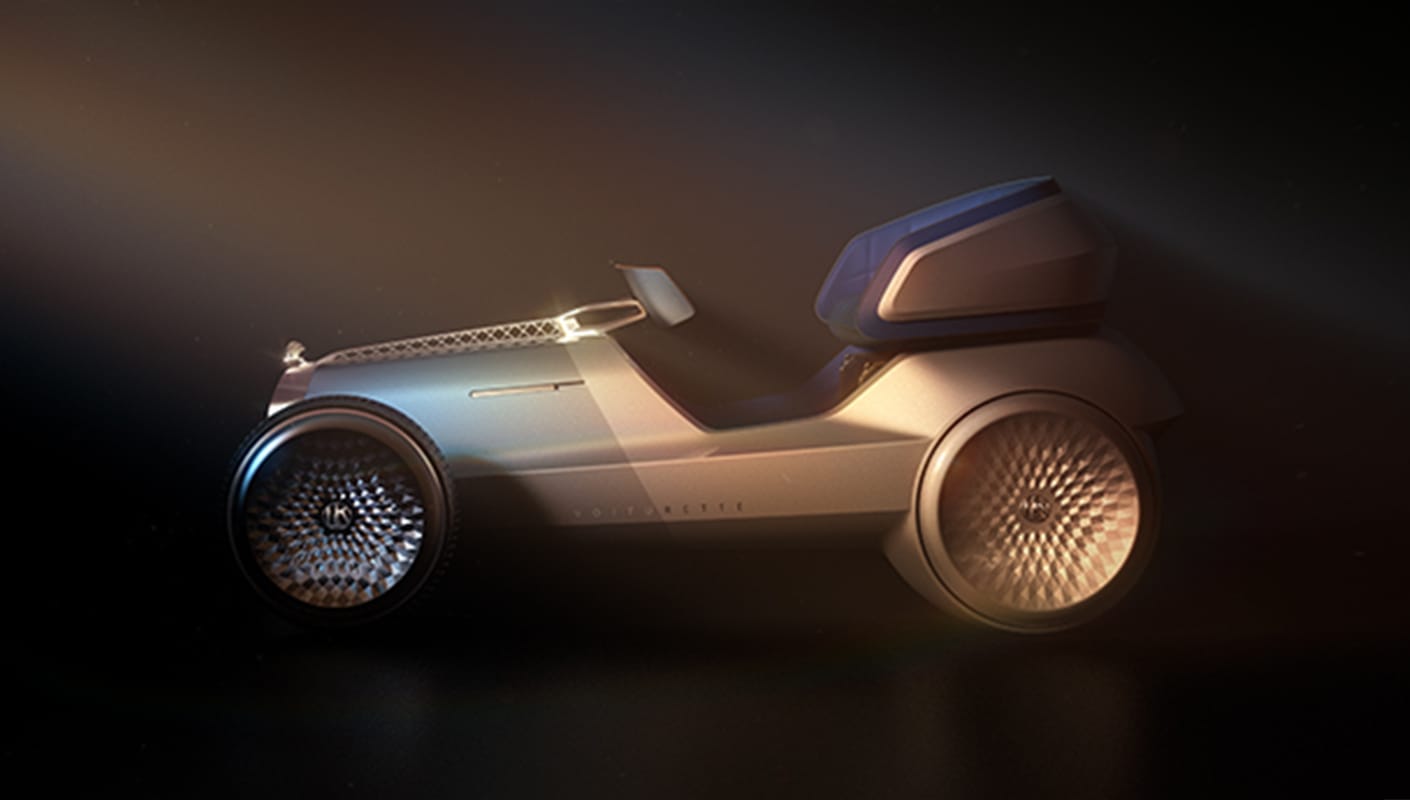Master subsurface scattering in V-Ray—understand it, use it, and optimize it for breathtakingly realistic renders.
As 3D artists, we always strive for the perfect render. Understanding the way that light interacts with objects is critical for achieving photorealism. While some objects reflect most of the light, others absorb it and then let it pass through at different points, in a concept called subsurface scattering (SSS). In this article, we’ll explore the ins and outs of subsurface scattering and learn how it can be used in V-Ray to create realistic renders.
Table of contents
The science behind subsurface scattering >
Subsurface scattering shaders and tools >
Components of subsurface scattering >
V-Ray material SSS properties and their applications >
Practical applications and case studies >
Challenges and optimization strategies >
To wrap it up >
FAQ >
The science behind subsurface scattering
Subsurface scattering occurs when light passes through a translucent surface like a glass of milk or the leaves on a sunny morning, is absorbed, scattered, and re-emitted.
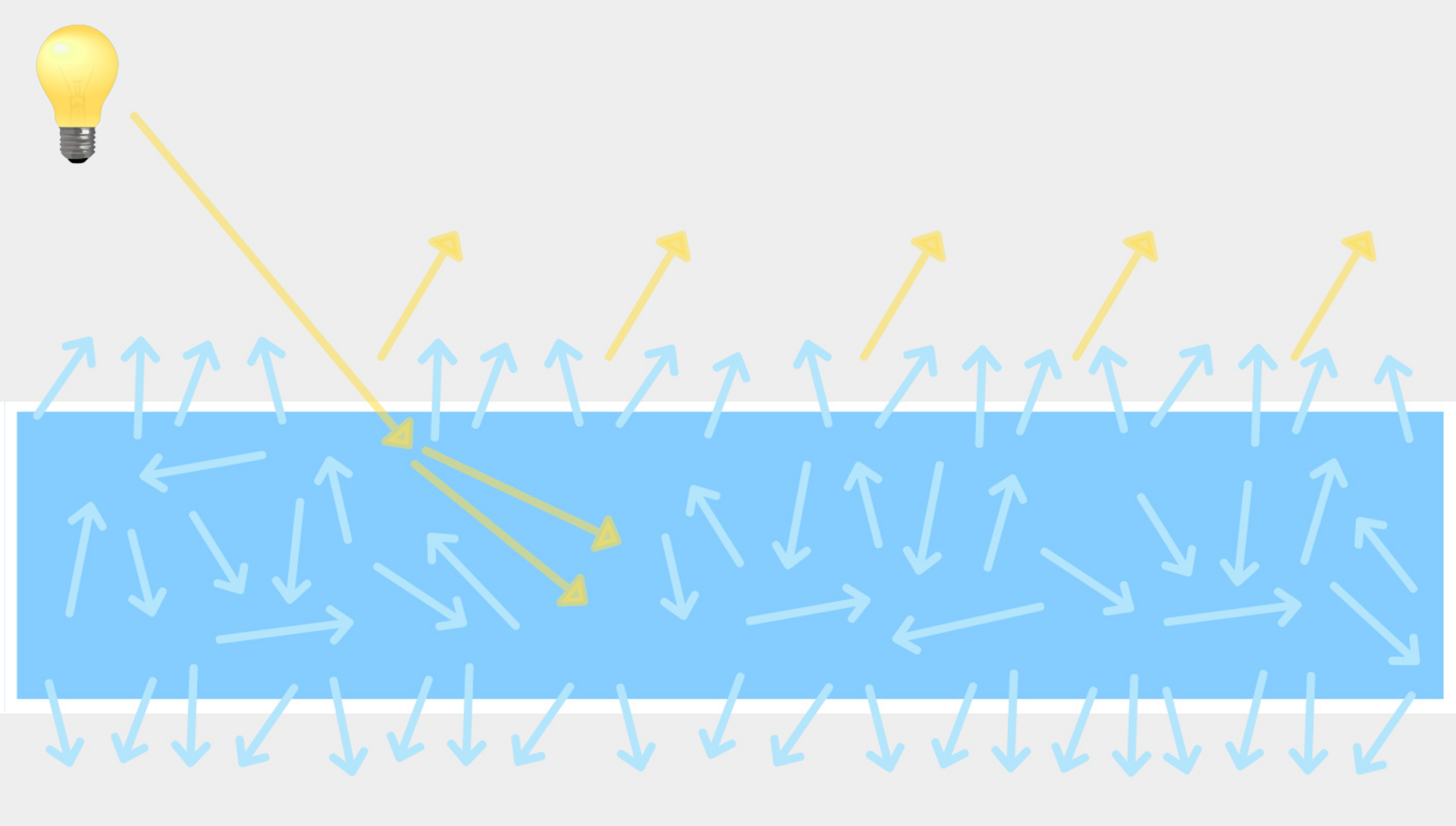
To better understand this concept, hold your hand up to the light, and you will notice a warm glow around it, illuminating your veins, pores, folds, and creases. Skin is one of the greatest examples of the SSS phenomenon, as less than 10% of the light is reflected directly off the surface, while the rest is scattered beneath the surface through subsurface scattering. In 3D graphics, if subsurface scattering is not applied, translucent objects like paper, wax, marble, and skin will look opaque and lack photorealism.
Subsurface Scattering Shaders and Tools
V-Ray offers a complete set of tools to render subsurface scattering. Let’s explore them below.
Physical subsurface scattering shaders
On one end of the spectrum, for those requiring the ultimate accuracy, the V-Ray Material, a physical SSS shader, includes a brute-force random walk approach that closely mimics real-world light behavior. This method is analogous to that found in the vrayScatterVolume shader and is well integrated with the rest of the shading layers in the material.
The various modes available in both shaders allow for great flexibility and resource budgeting, depending on the desired outcome—from thin liquids to dense alabaster, they can simulate it all with accuracy.
Fast shaders for look development
For quicker look development, with minor concessions to accuracy, V-Ray also offers the industry-renowned ALShader, a fast shader that is ideal for quickly setting up the simulation of skin and other such complex, multi-layered SSS materials. Also based on brute-force random walk, it offers directional and diffusion profiles to better suit the user's needs for looks and speed.
Rendering considerations
For these shaders to work at their best, the user must account for the full complement of lighting, global illumination, and ancillary geometry (e.g., seeds inside grapes).
Speed-Optimized SSS: The vrayFastSSS Shader
Lastly, the vrayFastSSS shader uses the seminal Jensen approach to quick sub-surface scattering calculations. (Refer to Jensen's seminal paper from 2001). It doesn't require global illumination, nor does it take into account the geometry lying below the shader's surface, but it can compute very convincing approximations of subsurface scattering in thick liquids, plants, and greenery in general, and even distant characters.
Components of subsurface scattering
Subsurface scattering can be broken down into different components based on how light interacts with the interior of a material. These interactions determine the softness, depth, color bleeding, light directionality, and translucency. While some materials are better suited for specific effects, you can experiment with all SSS components using just one type of material, like the skin on a human face pictured in the comparisons below.
Forward scattering
Forward scattering occurs when light enters an object and continues moving in the same direction as the original light ray. This is typical for thin or lightly translucent materials like leaves and skin, allowing light to exit on the other side.
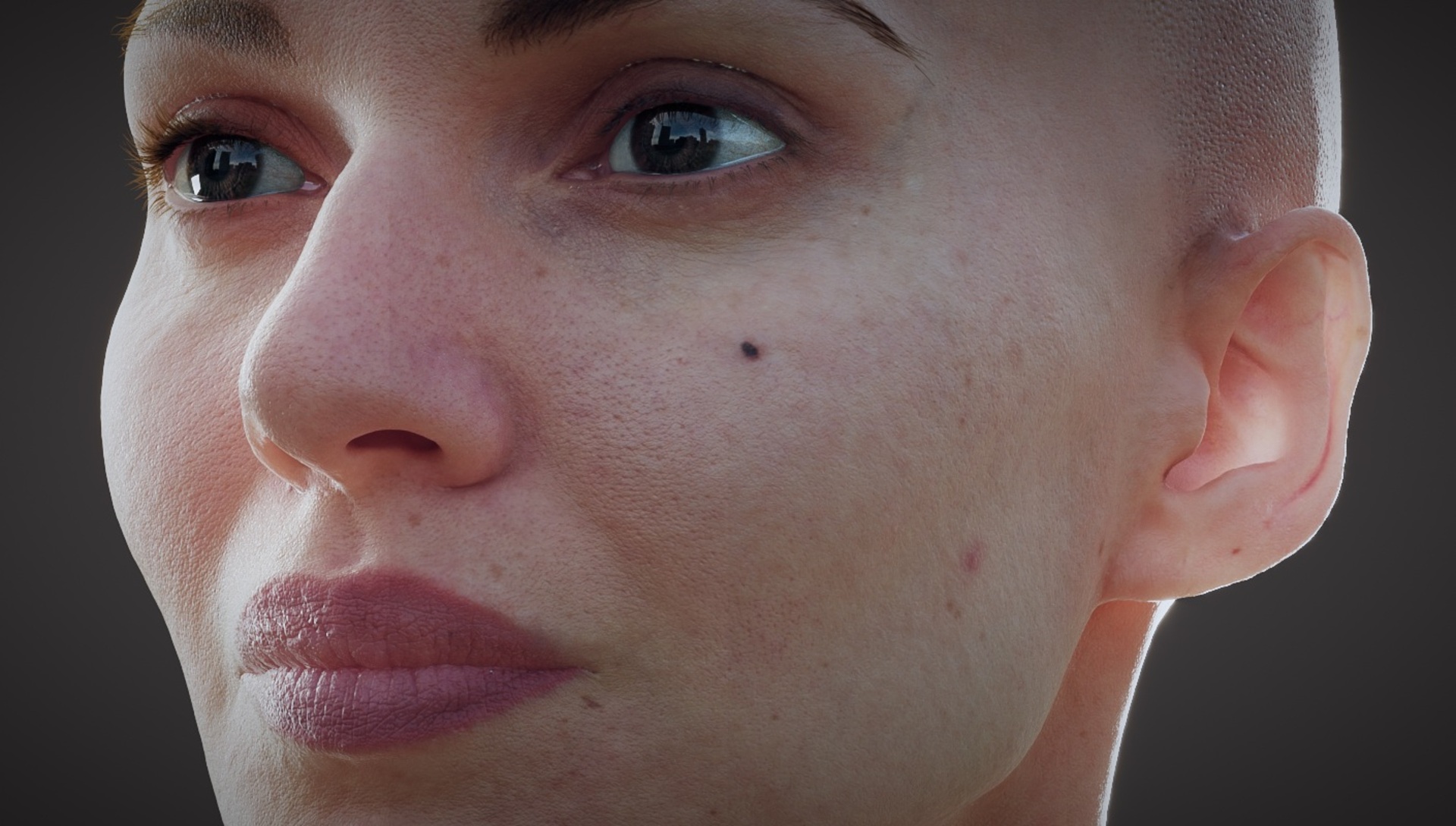
Back scattering
Back scattering occurs when light enters the surface of an object but is reflected back toward the direction it came from. It is more common in denser or more complex materials, where light bounces around chaotically beneath the surface. Picture the subtle softness on the lit side of human cheeks or the creamy look of yogurt.
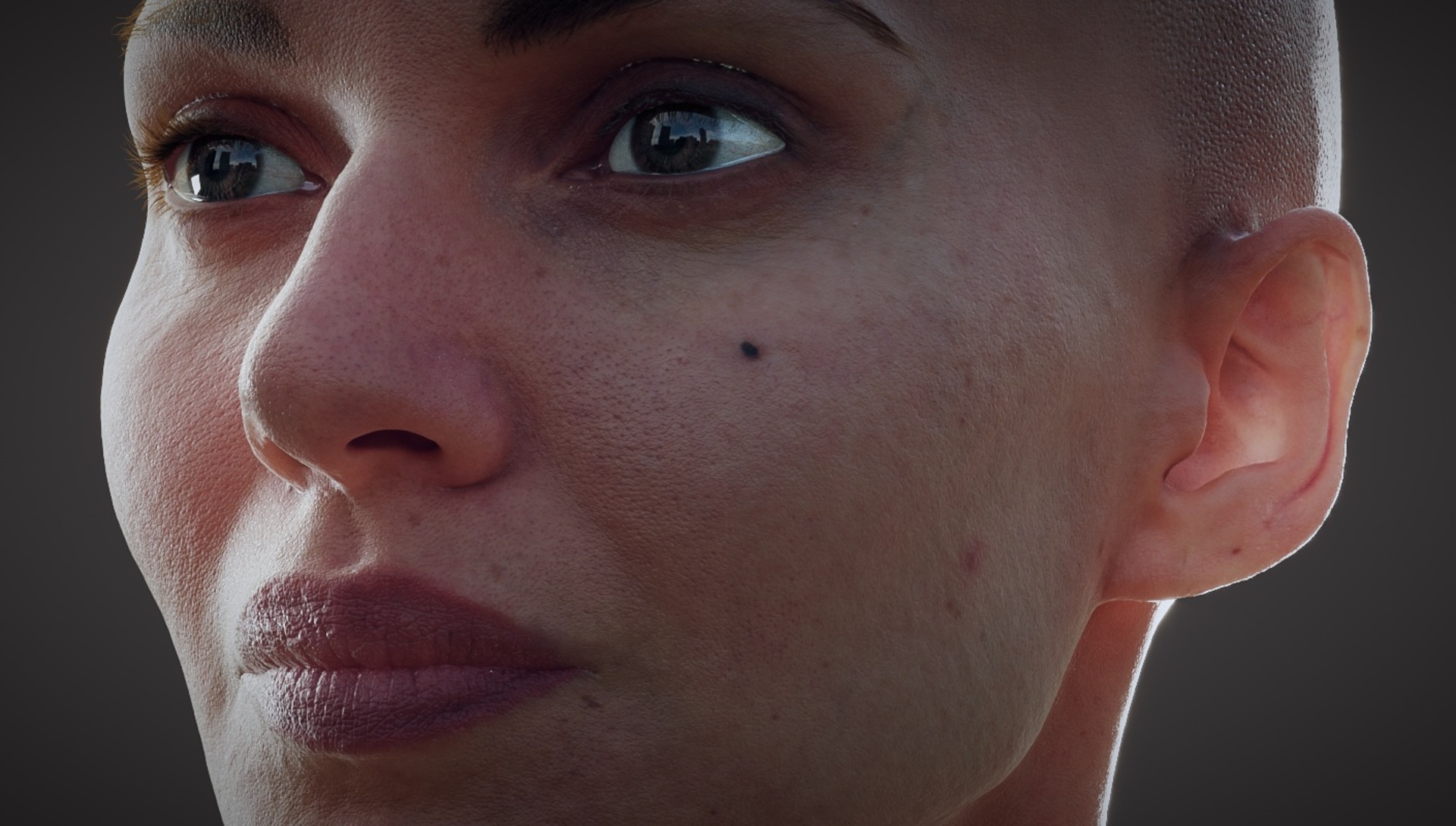
V-Ray material SSS properties and their applications
Achieving SSS is not a single toggle or setting in V-Ray but rather an effect that emerges from a combination of material choice, object properties (i.e., thickness variation, thin parts, curvature), and lighting conditions. When you combine these elements, they define the behavior of different shaders in V-Ray.
In V-Ray, a shader is the material that governs these interactions. A shader determines how a material behaves. Below are several V-Ray shaders that can be used to simulate different subsurface scattering (SSS) effects along with their unique characteristics.
| Shader | Implementation | Characteristics |
|---|---|---|
| VRayMtl | 3ds Max, Maya, Blender, Cinema 4D, Rhino, SketchUp, Houdini, Revit |
|
| VRayFastSSS2 | 3ds Max, Maya, Blender, Cinema 4D, Rhino, SketchUp |
|
| VRayAlSurface | 3ds Max, Maya, Cinema 4D, Blender, Houdini |
|
| VRayScatterVolume | 3ds Max, Blender, Cinema 4D |
|
| VRay2SidedMtl | 3ds Max, Maya, Blender, Cinema 4D, Rhino, SketchUp, Houdini, Revit |
|
Using Volumetric Scattering (VRayMtl)
Jade/Marble Dragon
- Apply a standard VRay material to the object.
- You could give it a little bit of reflectivity by setting the reflection color to mid-gray.
- Enabling refractions is an important step in enabling the VRay material's translucency capabilities. So, let’s set the refraction color to white.
- Next, we need to choose the translucency type. Let’s go for volumetric.
- By playing with the fog color and the depth, we can adjust the overall color of the material and its softness. Using the scatter color, we can set the color of the scatter.

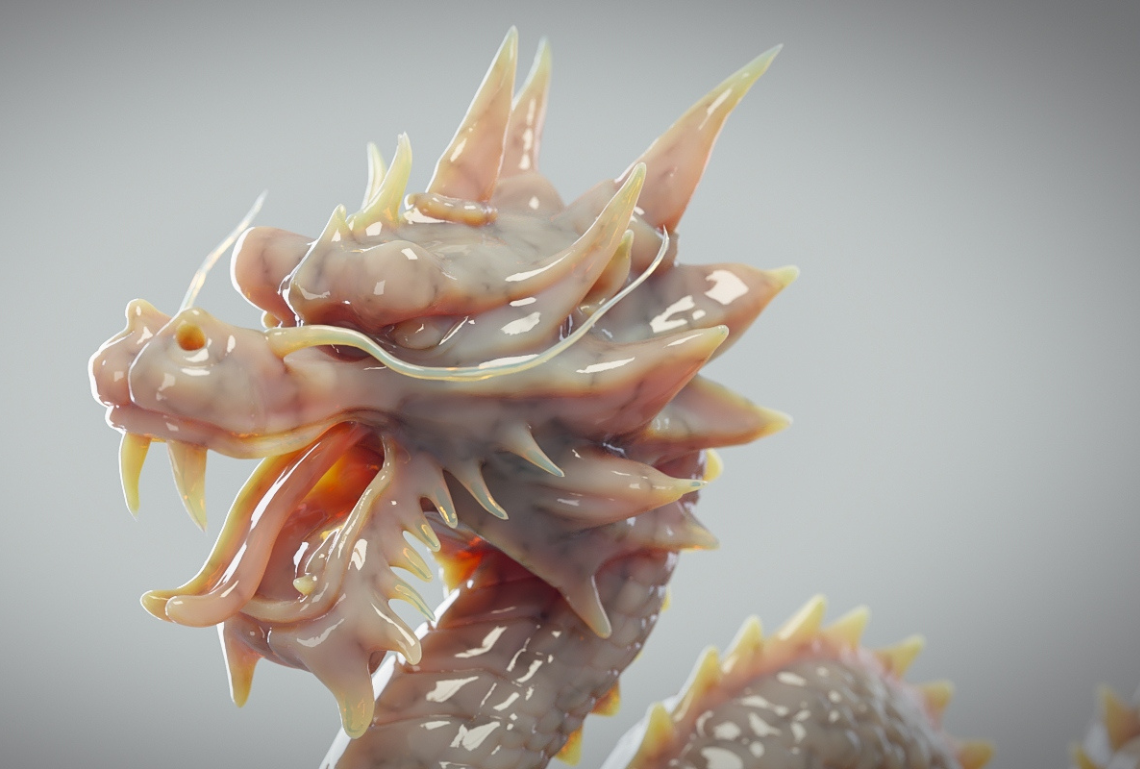
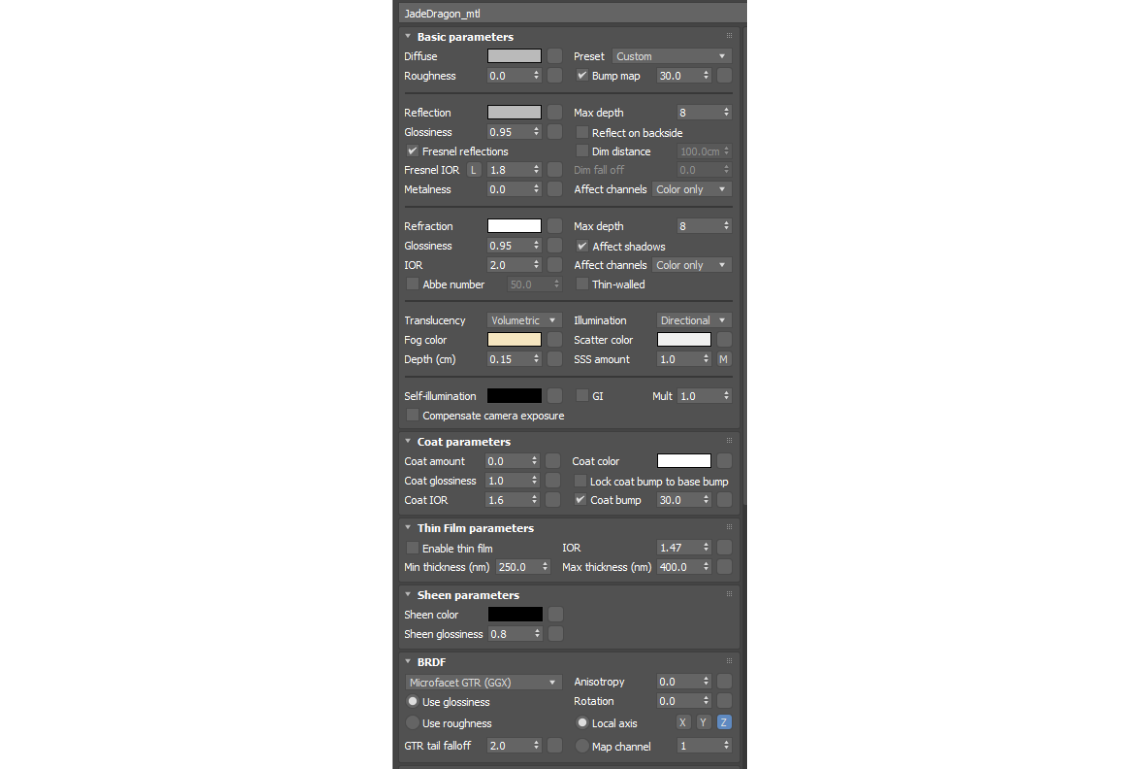
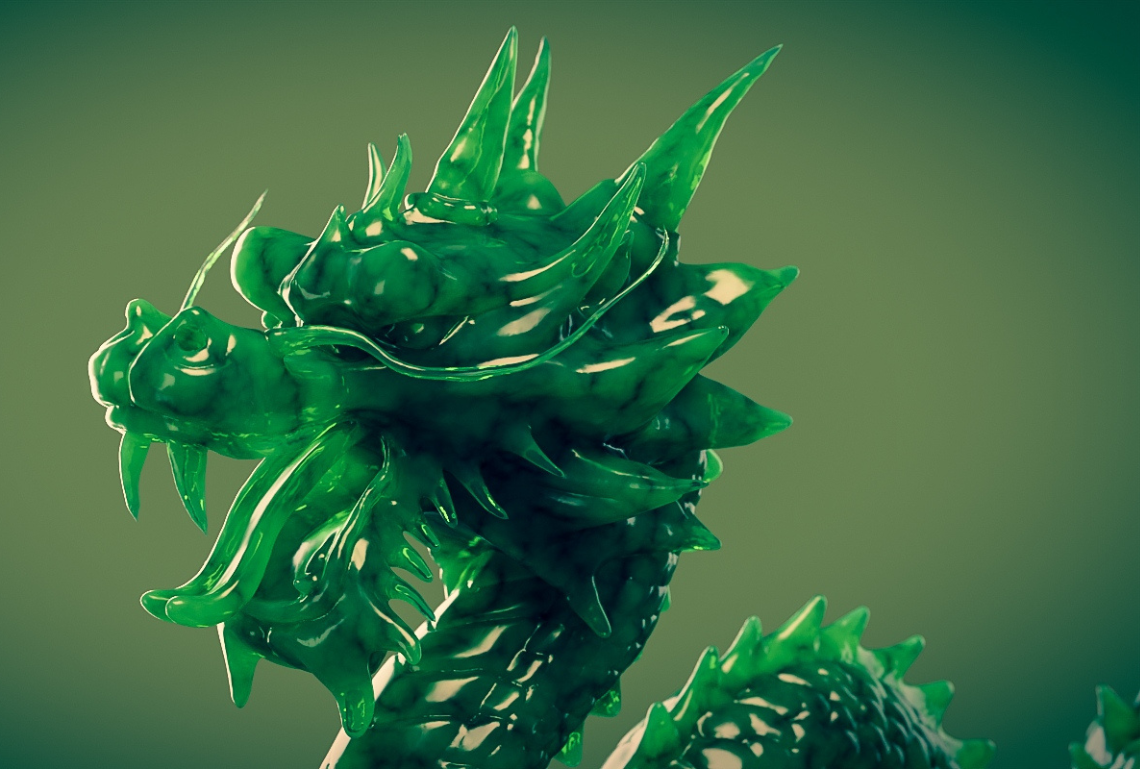


Using VRayFastSSS2
Candles
- Apply VRayFastSSS2 to your object—ideal for skin, wax, marble, and other organic materials.
- To create a wax material, we could play with the subsurface color and the scatter color. For example, we could set the sub-surface color to a yellow color, which is going to be the main color of the candle. And set the scatter color to orange, which is going to be visible in the thin parts of the candle geometry. This way, in the area around the flame of the candle, it’ll look more orange.
- Next, we can play with the scatter radius parameter. In the case of wax, it is a good idea to allow the light to scatter deeper beneath the surface, so 2 cm should suffice.
- Finally, for creating a material such as wax, we need more of a forward scattering approach, so let’s set the phase function to account for that to 0.8.
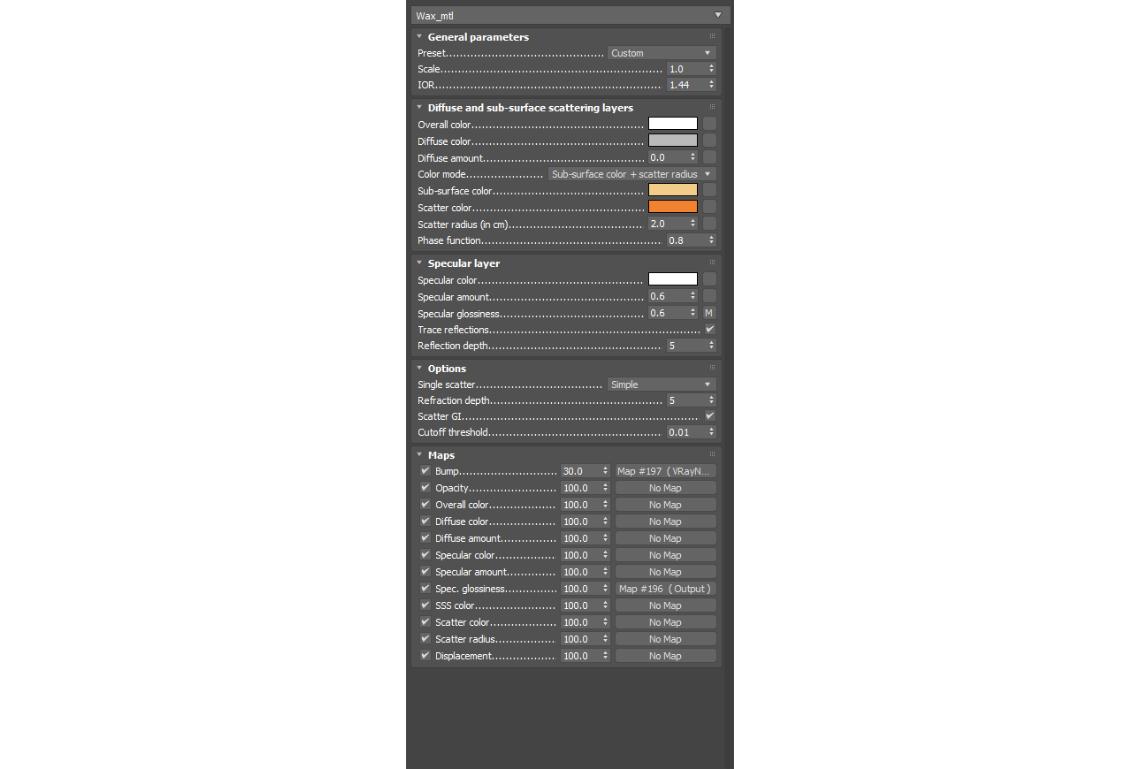



Using VrayAlSurface
Woman closeup
- Apply VRayAlSurface to your object—this shader is versatile and designed for realistic skin and layered materials.
- Set the diffuse color for the overall look of the material. It could be a flat color or a texture map. In this example, a texture map was used.
- Make sure you enable subsurface scattering by setting the “SSS mix” parameter to 1.0
- You could experiment with the parameters and colors of the three SSS layers to achieve the type of skin you’re after. The default values are getting pretty decent results too.
- If you have a normal or bump texture, you could also plug it in to give your material an extra level of detail.
- Finally, you could adjust the reflectivity of the material by playing with the reflection color and roughness parameter.

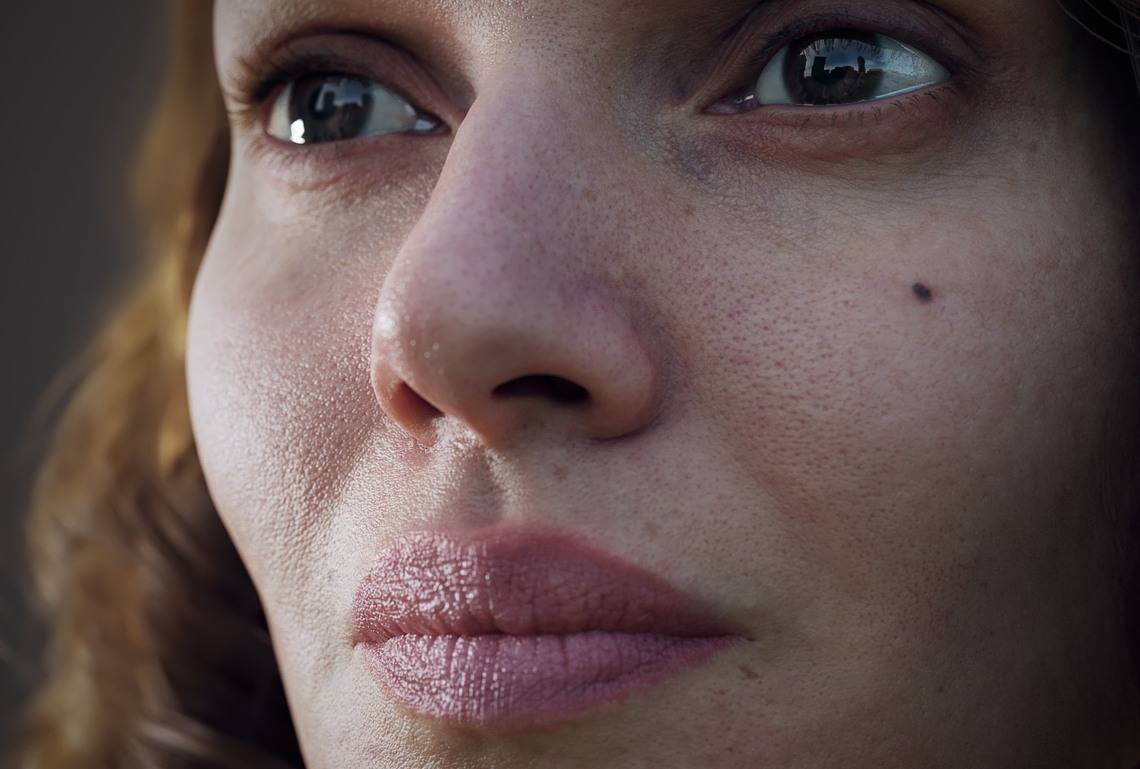


Using VRayFastSSS2
Forward/Backward/Isotropic Scattering
- Apply VRayFastSSS2 to your object—ideal for skin, wax, marble, and other organic materials.
- Set an overall color or texture that would serve as a base color.
- You could play with the scatter color to adjust the subsurface scattering color of the material. It is mostly visible in the thin parts of the geometry. (Ears of a character, for instance).
- By adjusting the scatter radius parameter, you can control the depth of scattering light inside the material.
- Finally, you can switch between several types of scattering using the phase function parameter. If the phase function parameter is set to ,0 that is called isotropic scattering. It means that light scatters uniformly in all directions (see example in image 01). A value of -1.0 would trigger backward scattering. In this condition, most of the light bounces back to the direction it came from (see example in image02). And finally, a value of 1.0 would trigger forward scattering. In this condition, the light scatters predominantly forward (see example in image 03).
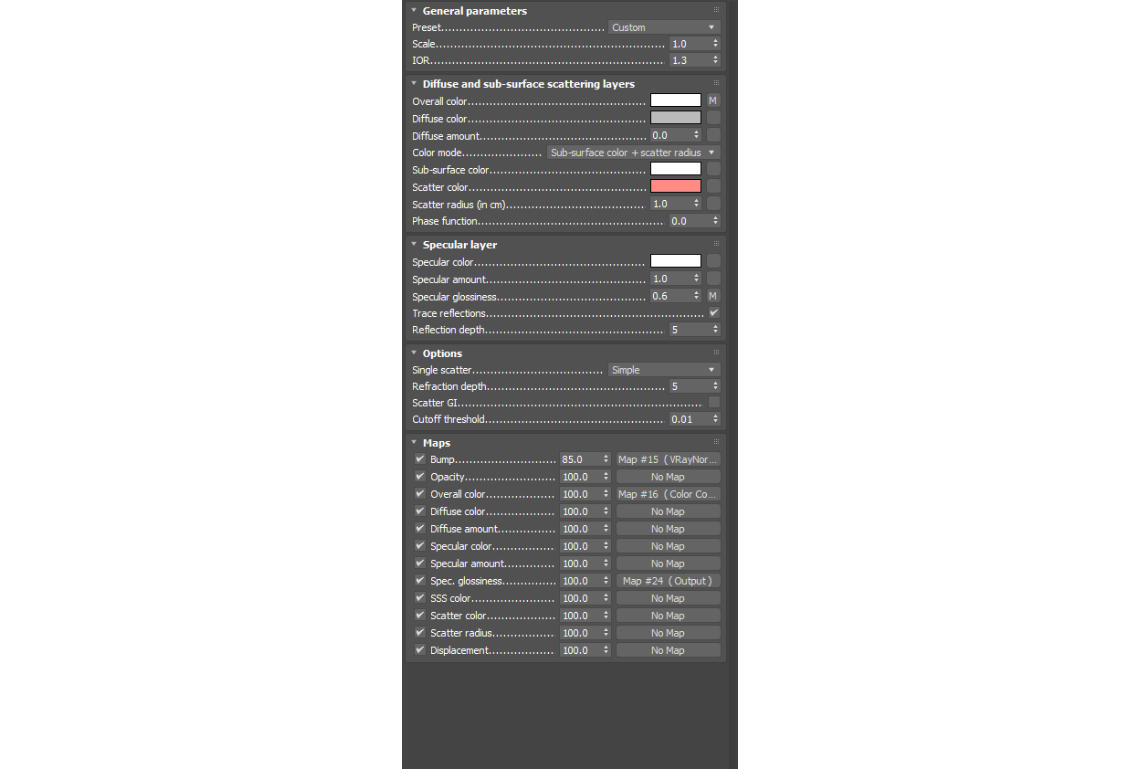

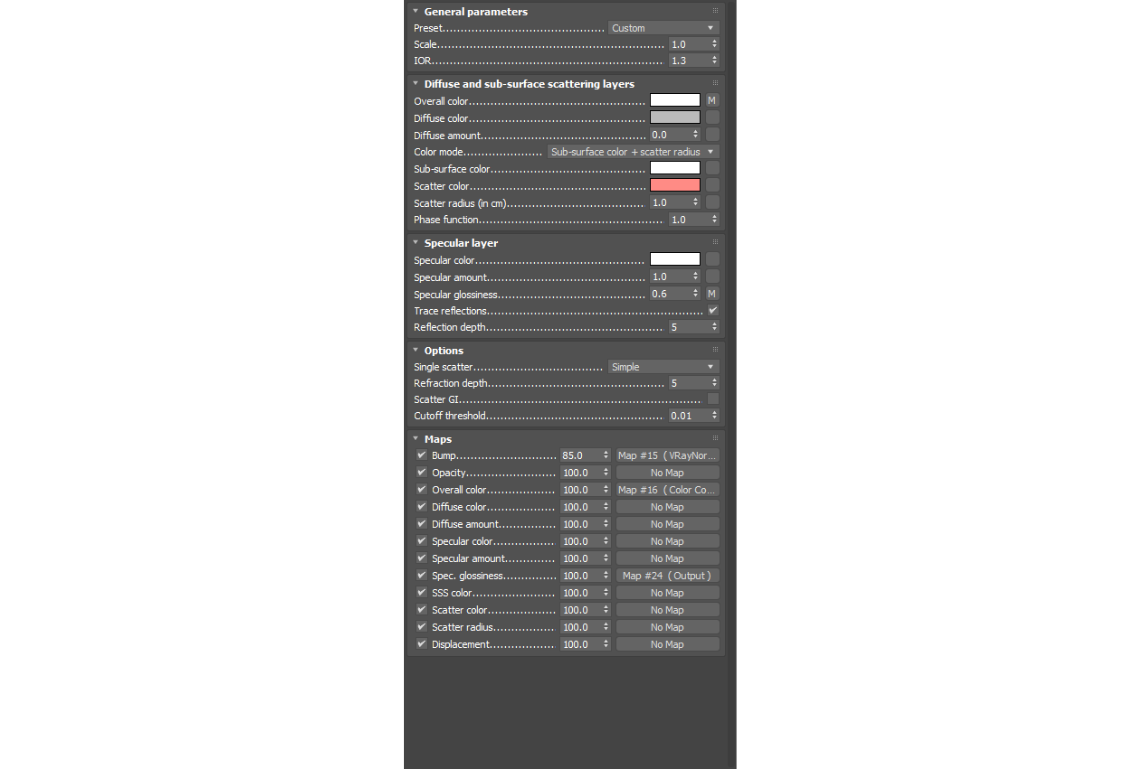

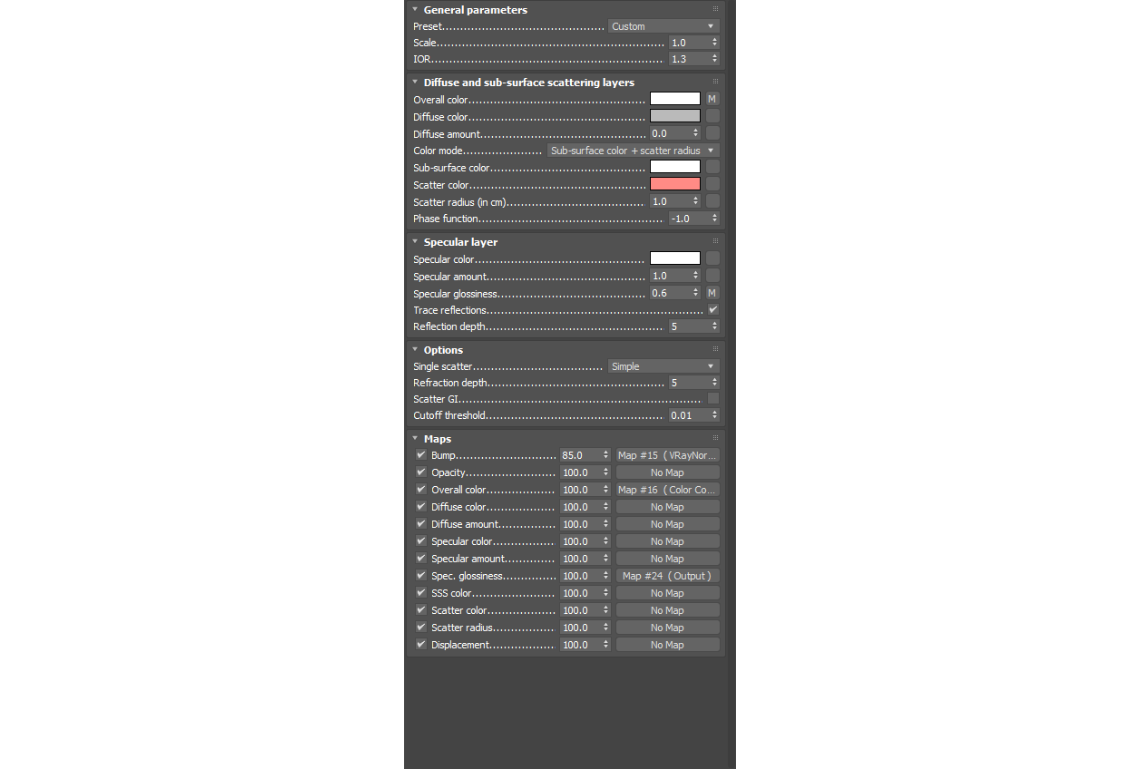



Using VRayScatterVolume
Icy sphere
- The VRayScatterVolume material is designed solely as a brute-force option for SSS to produce an unbiased result. When used as a base material in a VRayBlendMtl, it can create complex materials with a subsurface scattering base. For example, we could create an ice material using the VRayScatterVolume.
- We need to set an overall color to serve as a base. We could choose light blue.
- Next, we can experiment with the sub-surface and scatter color until we get the result we’re after.
- We should also experiment with the scatter radius parameter to control how deeply the light scatters under the surface.
- Finally, we can adjust the phase function parameter. To create ice, we could set the phase function parameter to 0.15 to slightly favor forward scattering.
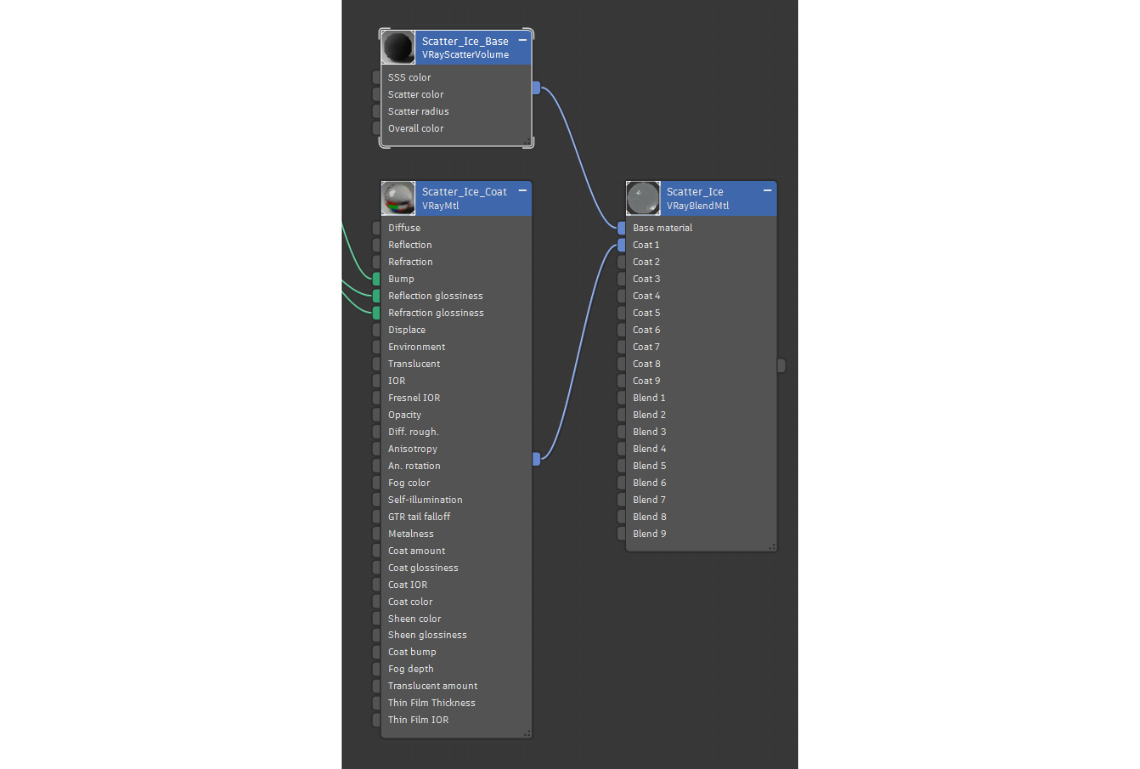

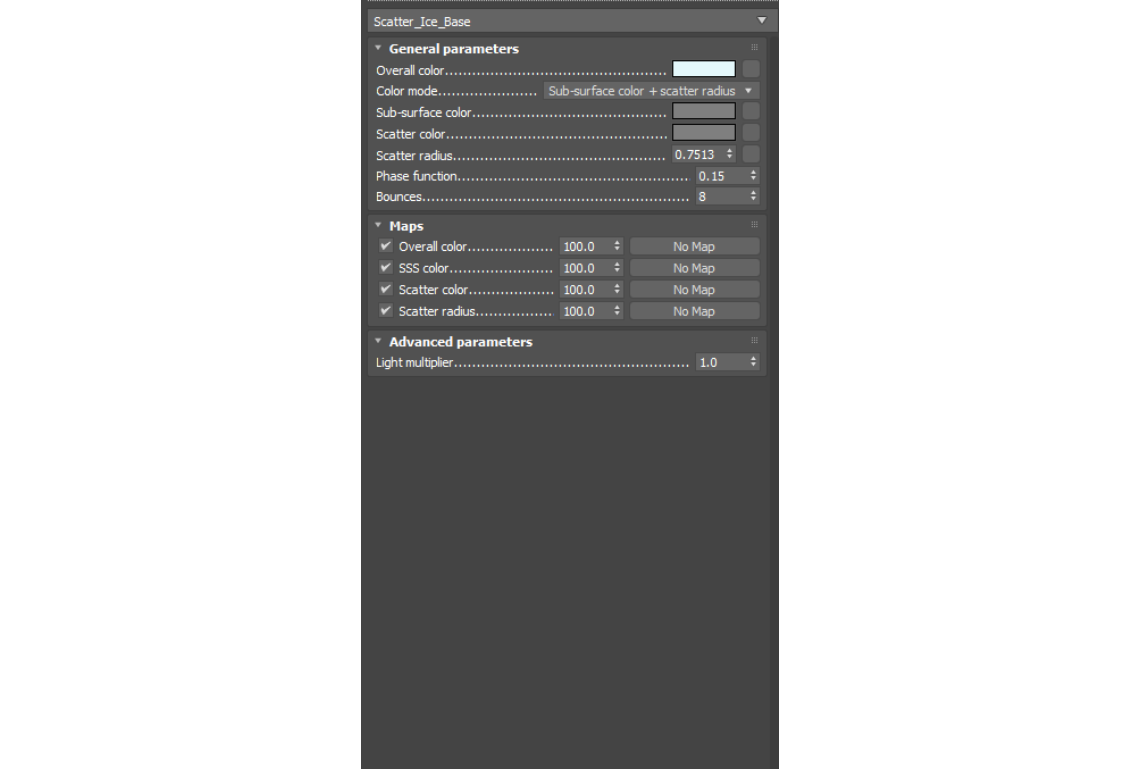


Using VRay2SidedMtl
Autumn leaves
- The VRay2SidedMtl material is designed solely as a brute-force option for SSS to produce an unbiased result. When used as a base material in a VRayBlendMtl, it can create complex materials with a subsurface scattering base. For example, we could create an ice material using the VRayScatterVolume.
- We need to set an overall color to serve as a base. We could choose light blue.
- Next, we can experiment with the sub-surface and scatter color until we get the result we’re after.
- We should also experiment with the scatter radius parameter to control how deeply the light scatters under the surface.
- Finally, we can adjust the phase function parameter. To create ice, we could set the phase function parameter to 0.15 to slightly favor forward scattering.
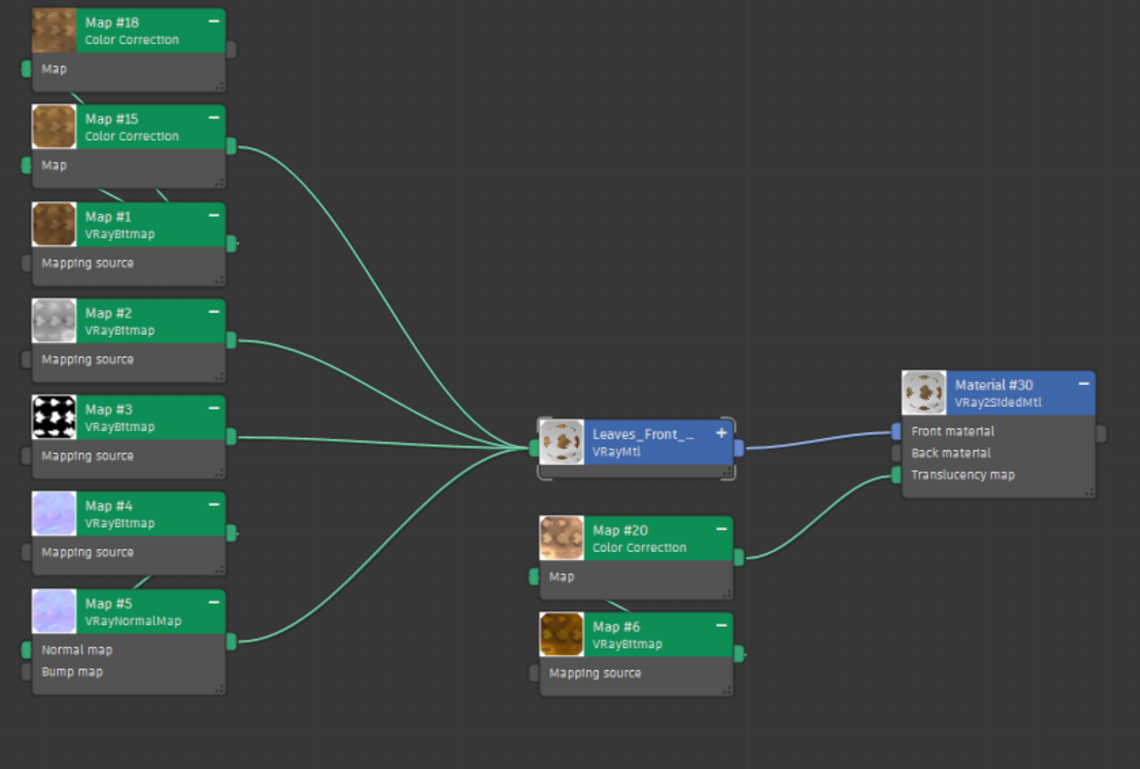



Practical applications and case studies
Digital portraiture and character design
An excellent example of SSS in action is the way backlit ears appear to glow in their thinner areas, revealing how light penetrates and scatters through these regions. Due to its ability to produce a remarkable level of realism, SSS often proves to be an invaluable technique for creating more detail in lifelike skin textures in digital portraiture and character design.
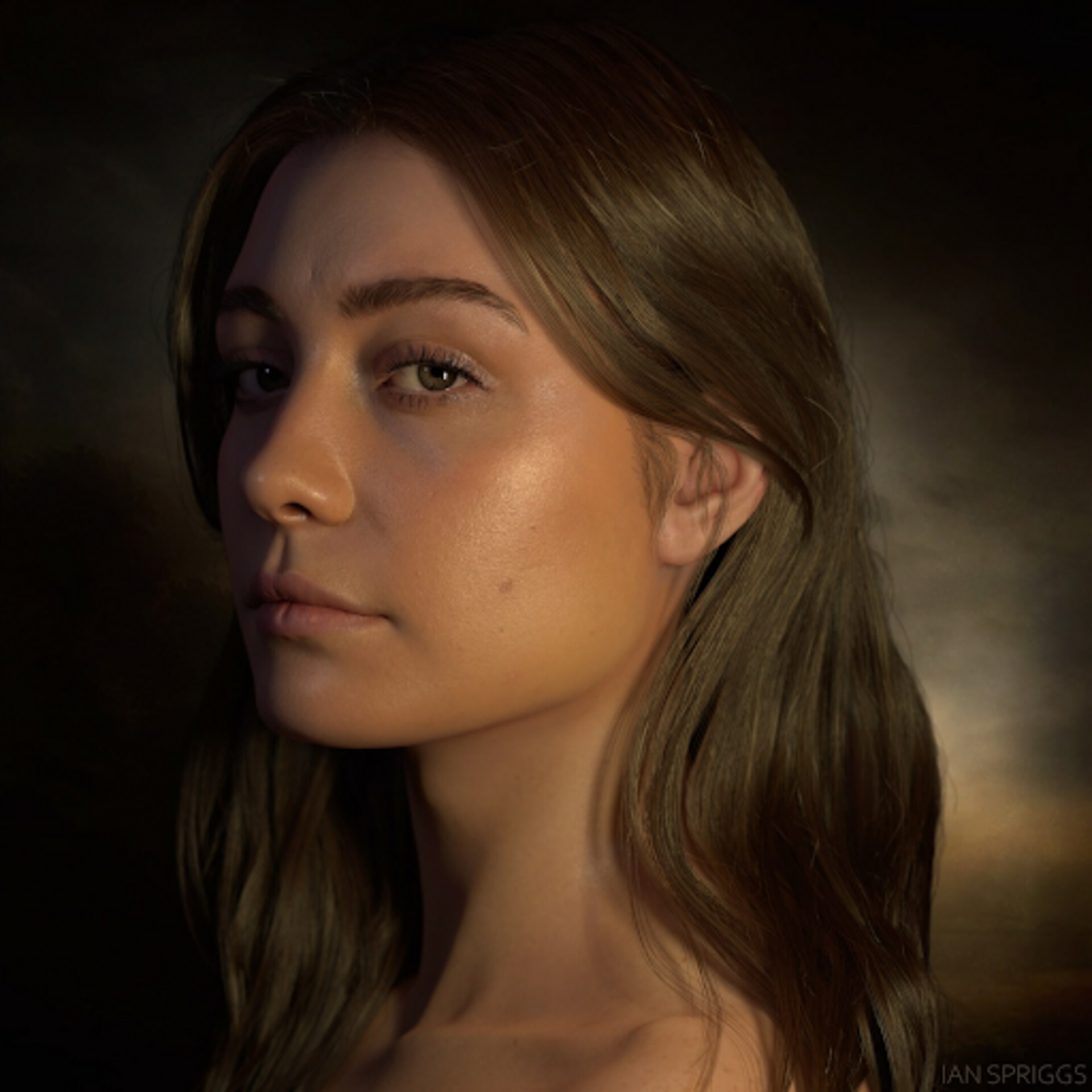
Game rendering and immersive environments
Another noticeable example of SSS is seen in lighting environments in which a strong directional backlight is used, while frontal lighting can diminish its visibility. This technique is commonly used in game rendering software to create immersive environments that draw players into the world, making them feel they are truly part of the game.
Product visualization in advertising
The technique is also in product visualization, particularly in advertising for cosmetics and food. SSS enhances the look of skin creams, lotions, and gels by giving them a soft, translucent quality that evokes richness and youth. When using 3D product design rendering software for visualizing food, SSS adds a high level of photorealism to items like candy, fresh fruit, and beverages of all sorts by simulating how light subtly scatters beneath their surfaces, making them appear more appetizing.
Case study: The wooden metropolis project
The Wooden Metropolis project not only serves as a great case study of SSS in V-Ray but also demonstrates the powerful social impact 3D visualization can convey. An advertisement for NGO Robin Wood, the project draws attention to the alarming rate of deforestation by addressing urbanization and highlighting that an area of woodland larger than New York City is lost every day. PX Group’s team relied on V-Ray's Fast SSS2 material to authentically replicate the appearance of fresh wood.
We began by looking at the tiniest piece of the puzzle: when a tree is split, the fresh splinters appear somewhat shiny, almost like porcelain or white chicken meat. On closer observation, reddish light gets scattered inside the splinter tips. In nature, this translucent effect is very subtle and most apparent when those splinters are lit from behind. We figured the most obvious shader to achieve this effect was V-Ray's Sub Surface Scattering material, fast SSS2.
Christian Sturm, 3D Artist
Challenges and optimization strategies
It’s important to remember that SSS may appear a bit off due to issues such as overlapping faces, solid objects that are not closed (holes, unwelded vertices), lack of thickness, and incorrect scaling. To prevent this from happening, try not to rush when working on a project. Ensure your geometry is clean by taking regular breaks, being observant, and fixing any object irregularities you spot.
To wrap it up
Substance scattering is an excellent tool for adding an extra level of photorealism to your renders. It takes into account the physical properties of light and the way it interacts with each unique object, preventing them from looking plastic-like and creating a realistic representation of the scene’s surroundings. We encourage you to experiment and play around with the different shaders in V-Ray and explore which ones incorporate best into your workflow.
FAQs
Should I use subsurface scattering?
You should definitely use SSS, especially for translucent objects. It can help make a huge difference in creating realistic skin, wax, marble, liquids, foliage, and more.
What objects have subsurface scattering?
Any semi-translucent material where scattered light diffuses inside — skin, wax, marble and jade, fruits, milk, juice, leaves are just some examples.
How can I improve my renders using subsurface scattering?
Use SSS for the right materials, and experiment with different shaders to see which one gets it just right.
Does enabling subsurface scattering increase render time?
Yes, but if used smartly, not by much. You can manage performance by using it selectively, and keeping in mind it’s a trade-off between time and quality.
Why is subsurface scattering important for 3D artists?
SSS mimics how light interacts with real-world materials through scattering. Without SSS, materials lack depth and look artificial — skin looks plastic, wax looks flat, and characters, close-ups, and product shots lack photorealism.





